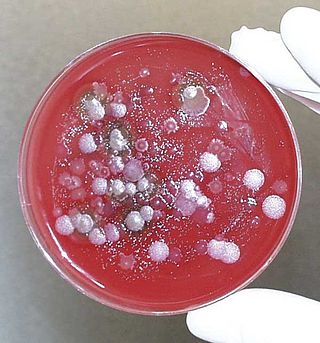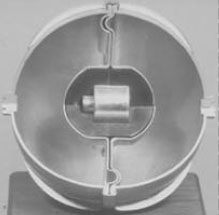Related Research Articles

The United States is known to have possessed three types of weapons of mass destruction: nuclear, chemical, and biological weapons. The U.S. is the only country to have used nuclear weapons on another country, when it detonated two atomic bombs over two Japanese cities of Hiroshima and Nagasaki during World War II. It had secretly developed the earliest form of the atomic weapon during the 1940s under the title "Manhattan Project". The United States pioneered the development of both the nuclear fission and hydrogen bombs. It was the world's first and only nuclear power for four years, from 1945 until 1949, when the Soviet Union produced its own nuclear weapon. The United States has the second-largest number of nuclear weapons in the world, after the Russian Federation.

The United Kingdom possesses, or has possessed, a variety of weapons of mass destruction, including nuclear, biological, and chemical weapons. The United Kingdom is one of the five official nuclear weapon states under the Treaty on the Non-Proliferation of Nuclear Weapons. The UK renounced the use of chemical and biological weapons in 1956 and subsequently destroyed its general stocks.

Biological weapons are pathogens used as weapons. In addition to these living or replicating pathogens, toxins and biotoxins are also included among the bio-agents. More than 1,200 different kinds of potentially weaponizable bio-agents have been described and studied to date.
The United States biological weapons program officially began in spring 1943 on orders from U.S. President Franklin D. Roosevelt. Research continued following World War II as the U.S. built up a large stockpile of biological agents and weapons. Over the course of its 27-year history, the program weaponized and stockpiled seven bio-agents — Bacillus anthracis (anthrax), Francisella tularensis (tularemia), Brucella spp (brucellosis), Coxiella burnetii (Q-fever), Venezuelan equine encephalitis virus, Botulinum toxin (botulism), and Staphylococcal enterotoxin B. The US also pursued basic research on many more bio-agents. Throughout its history, the U.S. bioweapons program was secret. It was later revealed that laboratory and field testing had been common. The official policy of the United States was first to deter the use of bio-weapons against U.S. forces and secondarily to retaliate if deterrence failed.

Project 112 was a biological and chemical weapon experimentation project conducted by the United States Department of Defense from 1962 to 1973.

The M139 bomblet was an American sub-munition designed for use in warheads as a chemical cluster munition. Each spherical bomblet held 590 grams (1.3 lb) of sarin nerve agent.

The E120 bomblet was a biological cluster bomb sub-munition developed to disseminate a liquid biological agent. The E120 was developed by the United States in the early 1960s.

The Deseret Test Center was a U.S. Army operated command in charge for testing chemical and biological weapons during the 1960s. The Deseret was headquartered at Fort Douglas, Utah, a former U.S. Army base.

The Flettner rotor bomblet was a U.S. biological sub-munition that was never mass-produced. Based on the vertical Flettner rotor which takes advantage of the Magnus effect, a force acting on a spinning body in a moving airstream, it was developed toward the end of the U.S. biological weapons program in the 1960s.
The M138 bomblet was a sub-munition of the U.S. chemical weapon, the M43 BZ cluster bomb. The bomblet contained BZ, an incapacitating agent and was developed with the M43 in 1962. The M138s, along with all other U.S. BZ weapons were destroyed during the 1980s.
The E14 munition was a cardboard sub-munition developed by the United States biological weapons program as an anti-crop weapon. In a series of field tests in 1955, the E14 was loaded with fleas and air-dropped.
The E61 anthrax bomblet was an American biological sub-munition for the E133 cluster bomb. This anti-personnel weapon was developed in the early 1950s and carried 35 milliliters of anthrax spores or another pathogen.
The M125 bomblet was a U.S. chemical sub-munition designed to deliver the nerve agent sarin. It was brought into service in 1954 with the M34 cluster bomb as part of the first U.S. air-delivered nerve agent weapon.

The MC-1 bomb was the first U.S. non-clustered air-dropped chemical munition. The 750-pound (340 kg) MC-1 was first produced in 1959 and carried the nerve agent sarin.

The M134 bomblet was a U.S. chemical sub-munition designed for use in the Honest John rocket during the 1950s. The weapon was never mass-produced and was supplanted in 1964 by an improved design, the M139.
The Vigo Ordnance Plant, also known as the Vigo Chemical Plant or simply Vigo Plant, was a United States Army facility built in 1942 to produce conventional weapons. In 1944 it was converted to produce biological agents for the U.S. bio-weapons program. Although the plant never actually produced bio-weapons before the end of World War II, it did produce 8000 pounds of an anthrax simulant. After the war, the plant was transferred to Pfizer, who operated it until the plants closure in 2008.
Before the 20th century, the use of biological agents took three major forms:
Operation Night Train was part of a series of chemical and biological warfare tests overseen by the Deseret Test Center as part of Project 112. The test was conducted near Fort Greely, Alaska from November 1963 to January 1964. The primary purpose of Night Train was to study the penetration of an arctic inversion by a biological aerosol cloud. The test's first purpose was to study the downwind travel and diffusion of this cloud when disseminated into different arctic meteorological regimes. All documents about Night Train were considered classified by the US military until 2002, when the Department of Defense (DOD) released medically relevant information of all the chemical and biological warfare agent tests conducted under Project 112.
Operation Sea-Spray was a 1950 U.S. Navy secret biological warfare experiment in which Serratia marcescens and Bacillus globigii bacteria were sprayed over the San Francisco Bay Area in California, in order to determine how vulnerable a city like San Francisco may be to a bioweapon attack.
References
- 1 2 3 Smart, Jeffery K. Medical Aspects of Chemical and Biological Warfare Archived 2012-08-26 at the Wayback Machine : Chapter 2 - History of Chemical and Biological Warfare: An American Perspective, (PDF: p. 51), Borden Institute , Textbooks of Military Medicine, PDF via Maxwell-Gunter Air Force Base, accessed November 12, 2008.
- 1 2 3 4 Countermeasures, Chapter 6 - An Overview of Emerging Missile State Countermeasures, p. 14, accessed November 12, 2008.
- 1 2 3 4 5 "Fact Sheet - Yellow Leaf Archived 2009-03-09 at the Wayback Machine ", Office of the Assistant Secretary of Defense (Health Affairs), Deployment Health Support Directorate, accessed November 12, 2008.
- 1 2 3 4 "Fact Sheet - Red Cloud Archived 2009-03-09 at the Wayback Machine ", Office of the Assistant Secretary of Defense (Health Affairs), Deployment Health Support Directorate, accessed November 12, 2008.
- ↑ "Project 112/SHAD Fact Sheets Archived 2008-12-20 at the Wayback Machine ", Force Health Protection & Readiness Policy & Programs, The Chemical-Biological Warfare Exposures Site, accessed November 13, 2008.